Long-Term Spatiotemporal Characteristics and Influencing Factors of Dust Aerosols in East Asia (2000–2022)
Abstract
1. Introduction
2. Materials and Methods
2.1. Study Area
2.2. Dataset
2.2.1. MERRA-2 AOD
2.2.2. Ground-Based Observation AOD
2.2.3. Data on Influencing Factors
2.3. Methodology
2.3.1. Linear Trend Analysis
2.3.2. Pearson’s r
2.3.3. Grey Relational Analysis
2.3.4. Geographical Detector
3. Results and Discussions
3.1. MERRA-2 AOD Data Accuracy Validation
3.2. Spatiotemporal Dynamic Characteristics of DAOD and Changing Trends
3.2.1. Interannual Distribution and Variation of DAOD
3.2.2. Intermonthly Distribution and Changes of DAOD
3.2.3. Interseasonal Distribution and Changes in DAOD
3.3. DAOD Influencing Factors and Their Trends
3.3.1. Meteorological Factors
3.3.2. Ground Conditions
3.3.3. Human Activities
3.4. DAOD Driver Analysis
3.4.1. Single-Factor Effect Analysis
3.4.2. Two-Factor Interaction Analysis
4. Conclusions
Author Contributions
Funding
Data Availability Statement
Acknowledgments
Conflicts of Interest
References
- Zhou, Y.; Gao, X.; Meng, X.; Lei, J.; Halik, U. Characteristics of the Spatio-Temporal Dynamics of Aerosols in Central Asia and Their Influencing Factors. Remote Sens. 2022, 14, 2684. [Google Scholar] [CrossRef]
- Gandham, H.; Dasari, H.P.; Langodan, S.; Karumuri, R.K.; Hoteit, I. Major Changes in Extreme Dust Events Dynamics Over the Arabian Peninsula during 2003–2017 Driven by Atmospheric Conditions. J. Geophys. Res.-Atmos. 2020, 125, e2020JD032931. [Google Scholar] [CrossRef]
- Ku, B.; Park, R.J. Comparative inverse analysis of satellite (MODIS) and ground (PM10) observations to estimate dust emissions in East Asia. Asia-Pac. J. Atmos. Sci. 2013, 49, 3–17. [Google Scholar] [CrossRef]
- Li, J.; Han, Y.; Liu, W.; Cao, L.; Lu, Z. Contributions of gust under stationery weather conditions to the dust aerosol budget in northwestern China. Atmos. Res. 2023, 293, 106914. [Google Scholar] [CrossRef]
- Lin, C.-Y.; Chou, C.C.K.; Wang, Z.; Lung, S.-C.; Lee, C.-T.; Yuan, C.-S.; Chen, W.-N.; Chang, S.-Y.; Hsu, S.-C.; Chen, W.-C.; et al. Impact of different transport mechanisms of Asian dust and anthropogenic pollutants to Taiwan. Atmos. Environ. 2012, 60, 403–418. [Google Scholar] [CrossRef]
- Chappell, A.; Webb, N.P.; Hennen, M.; Schepanski, K.; Ciais, P.; Balkanski, Y.; Zender, C.S.; Tegen, I.; Zeng, Z.; Tong, D.; et al. Satellites reveal Earth’s seasonally shifting dust emission sources. Sci. Total Environ. 2023, 883, 163452. [Google Scholar] [CrossRef]
- Chen, W.; Meng, H.; Song, H.; Zheng, H. Progress in Dust Modelling, Global Dust Budgets, and Soil Organic Carbon Dynamics. Land 2022, 11, 176. [Google Scholar] [CrossRef]
- Nakashima, M.; Dagsson-Waldhauserova, P. A 60 Year Examination of Dust Day Activity and Its Contributing Factors From Ten Icelandic Weather Stations From 1950 to 2009. Front. Earth Sci. 2019, 6, 245. [Google Scholar] [CrossRef]
- Pinker, R.T.; Pandithurai, G.; Holben, B.N.; Dubovik, O.; Aro, T.O. A dust outbreak episode in sub-Sahel West Africa. J. Geophys. Res.-Atmos. 2001, 106, 22923–22930. [Google Scholar] [CrossRef]
- Song, H.; Zhang, K.; Piao, S.; Wan, S. Spatial and temporal variations of spring dust emissions in northern China over the last 30 years. Atmos. Environ. 2016, 126, 117–127. [Google Scholar] [CrossRef]
- VanCuren, R.A. Asian aerosols in North America: Extracting the chemical composition and mass concentration of the Asian continental aerosol plume from long-term aerosol records in the western United States. J. Geophys. Res.-Atmos. 2003, 108, 4623. [Google Scholar] [CrossRef]
- Wang, J.; Xia, X.G.; Wang, P.C.; Christopher, S.A. Diurnal variability of dust aerosol optical thickness and Angstrom exponent over dust source regions in China. Geophys. Res. Lett. 2004, 31, L08107.1–L08107.4. [Google Scholar] [CrossRef]
- Kaufman, Y.J.; Tanre, D.; Dubovik, O.; Karnieli, A.; Remer, L.A. Absorption of sunlight by dust as inferred from satellite and ground-based remote sensing. Geophys. Res. Lett. 2001, 28, 1479–1482. [Google Scholar] [CrossRef]
- Li, J.; Wong, M.S.; Lee, K.H.; Nichol, J.; Chan, P.W. Review of dust storm detection algorithms for multispectral satellite sensors. Atmos. Res. 2021, 250, 105398. [Google Scholar] [CrossRef]
- Xiong, J.; Zhao, T.; Han, Y.; Gong, S.L. A simulation of dust aerosols source and sink distributions and vertical profiles in East Asia over 1995~2004. China Environ. Sci. 2013, 33, 961–968. [Google Scholar]
- Zhang, X.Y.; Gong, S.L.; Zhao, T.L.; Arimoto, R.; Wang, Y.Q.; Zhou, Z.J. Sources of Asian dust and role of climate change versus desertification in Asian dust emission. Geophys. Res. Lett. 2003, 30, 2272. [Google Scholar] [CrossRef]
- Yumimoto, K.; Takemura, T. Long-term inverse modeling of Asian dust: Interannual variations of its emission, transport, deposition, and radiative forcing. J. Geophys. Res.-Atmos. 2015, 120, 1582–1607. [Google Scholar] [CrossRef]
- Filonchyk, M. Characteristics of the severe March 2021 Gobi Desert dust storm and its impact on air pollution in China. Chemosphere 2022, 287, 132219. [Google Scholar] [CrossRef]
- Stone, E.A.; Yoon, S.C.; Schauer, J.J. Chemical Characterization of Fine and Coarse Particles in Gosan, Korea during Springtime Dust Events. Aerosol Air Qual. Res. 2011, 11, 31–43. [Google Scholar] [CrossRef]
- Mori, I.; Nishikawa, M.; Quan, H.; Morita, M. Estimation of the concentration and chemical composition of kosa aerosols at their origin. Atmos. Environ. 2002, 36, 4569–4575. [Google Scholar] [CrossRef]
- Husar, R.B.; Tratt, D.M.; Schichtel, B.A.; Falke, S.R.; Li, F.; Jaffe, D.; Gasso, S.; Gill, T.; Laulainen, N.S.; Lu, F.; et al. Asian dust events of April 1998. J. Geophys. Res.-Atmos. 2001, 106, 18317–18330. [Google Scholar] [CrossRef]
- Meinander, O.; Dagsson-Waldhauserova, P.; Amosov, P.; Aseyeva, E.; Atkins, C.; Baklanov, A.; Baldo, C.; Barr, S.L.; Barzycka, B.; Benning, L.G.; et al. Newly identified climatically and environmentally significant high-latitude dust sources. Atmos. Chem. Phys. 2022, 22, 11889–11930. [Google Scholar] [CrossRef]
- Bory, A.J.M.; Biscaye, P.E.; Svensson, A.; Grousset, F.E. Seasonal variability in the origin of recent atmospheric mineral dust at NorthGRIP, Greenland. Earth Planet. Sci. Lett. 2002, 196, 123–134. [Google Scholar] [CrossRef]
- Kang, L.; Chen, S.; Huang, J.; Zhao, S.; Ma, X.; Yuan, T.; Zhang, X.; Xie, T. The Spatial and Temporal Distributions of Absorbing Aerosols over East Asia. Remote Sens. 2017, 9, 50. [Google Scholar] [CrossRef]
- Proestakis, E.; Amiridis, V.; Marinou, E.; Georgoulias, A.K.; Solomos, S.; Kazadzis, S.; Chimot, J.; Che, H.Z.; Alexandri, G.; Binietoglou, I.; et al. Nine-year spatial and temporal evolution of desert dust aerosols over South and East Asia as revealed by CALIOP. Atmos. Chem. Phys. 2018, 18, 1337–1362. [Google Scholar] [CrossRef]
- Gui, L.; Tao, M.H.; Wang, Y.; Wang, L.C.; Chen, L.F.; Lin, C.Q.; Tao, J.H.; Wang, J.; Yu, C. Climatology of aerosol types and their vertical distribution over East Asia based on CALIPSO lidar measurements. Int. J. Climatol. 2022, 42, 6042–6054. [Google Scholar] [CrossRef]
- Li, J.; He, Q.; Ge, X.; Abbas, A. Spatiotemporal distribution of aerosols over the Tibet Plateau and Tarim Basin (1980–2020). J. Clean. Prod. 2022, 374, 133958. [Google Scholar] [CrossRef]
- Che, H.; Gui, K.; Xia, X.; Wang, Y.; Holben, B.N.; Goloub, P.; Cuevas-Agullo, E.; Wang, H.; Zheng, Y.; Zhao, H.; et al. Large contribution of meteorological factors to inter-decadal changes in regional aerosol optical depth. Atmos. Chem. Phys. 2019, 19, 10497–10523. [Google Scholar] [CrossRef]
- Khan, M.; Tariq, S.; Ul Haq, Z. Variations in the aerosol index and its relationship with meteorological parameters over Pakistan using remote sensing. Environ. Sci. Pollut. Res. 2023, 30, 47913–47934. [Google Scholar] [CrossRef]
- Li, J.; He, Q.; Ge, X.; Abbas, A.; Jin, L. Spatio-temporal changes of AOD in Xinjiang of China from 2000 to 2019: Which factor is more influential, natural factor or human factor? PLoS ONE 2021, 16, e0253942. [Google Scholar] [CrossRef]
- Liu, J.; Ding, J.; Li, X.; Zhang, J.; Liu, B. Identification of dust aerosols, their sources, and the effect of soil moisture in Central Asia. Sci. Total Environ. 2023, 868, 161575. [Google Scholar] [CrossRef] [PubMed]
- Ma, W.; Ding, J.; Jin, X. Spatial heterogeneity and driving factors of aerosol in Western China: Analysis on multiangle implementation of atmospheric correction-aerosol optical depth in Xinjiang over 2001–2019. Int. J. Climatol. 2023, 43, 1993–2011. [Google Scholar] [CrossRef]
- Zheng, Y.; Wang, X.; Zhang, X.; Hu, G. Multi-spatiotemporal patterns of aerosol optical depth and influencing factors during 2000–2020 from two spatial perspectives: The entire Yellow River Basin region and its urban agglomerations. Int. J. Appl. Earth Obs. Geoinf. 2022, 106, 102643. [Google Scholar] [CrossRef]
- Jin, C.; Xue, Y.; Jiang, X.; Wu, S.; Sun, Y. Retrieval and validation of long-term aerosol optical depth from AVHRR data over China. Int. J. Digit. Earth 2022, 15, 1817–1832. [Google Scholar] [CrossRef]
- Seidel, F.C.; Kokhanovsky, A.A.; Schaepman, M.E. Fast retrieval of aerosol optical depth and its sensitivity to surface albedo using remote sensing data. Atmos. Res. 2012, 116, 22–32. [Google Scholar] [CrossRef]
- Wei, X.; Chang, N.-B.; Bai, K.; Gao, W. Satellite remote sensing of aerosol optical depth: Advances, challenges, and perspectives. Crit. Rev. Environ. Sci. Technol. 2020, 50, 1640–1725. [Google Scholar] [CrossRef]
- Xia, X.; Wang, P.; Wang, Y.; Li, Z.; Xin, J.; Liu, J.; Chen, H. Aerosol optical depth over the Tibetan Plateau and its relation to aerosols over the Taklimakan Desert. Geophys. Res. Lett. 2008, 35, L16804. [Google Scholar] [CrossRef]
- Xu, H.; Guang, J.; Xue, Y.; de Leeuw, G.; Che, Y.H.; Guo, J.; He, X.W.; Wang, T.K. A consistent aerosol optical depth (AOD) dataset over mainland China by integration of several AOD products. Atmos. Environ. 2015, 114, 48–56. [Google Scholar] [CrossRef]
- Zong, X.; Xia, X.; Che, H. Validation of aerosol optical depth and climatology of aerosol vertical distribution in the Taklimakan Desert. Atmos. Pollut. Res. 2015, 6, 239–244. [Google Scholar] [CrossRef][Green Version]
- Aldabash, M.; Balcik, F.B.; Glantz, P. Validation of MODIS C6.1 and MERRA-2 AOD Using AERONET Observations: A Comparative Study over Turkey. Atmosphere 2020, 11, 905. [Google Scholar] [CrossRef]
- Yousefi, R.; Wang, F.; Ge, Q.S.; Shaheen, A. Long-term aerosol optical depth trend over Iran and identi fication of dominant aerosol types. Sci. Total Environ. 2020, 722, 137906. [Google Scholar] [CrossRef]
- Sabetghadam, S.; Alizadeh, O.; Khoshsima, M.; Pierleoni, A. Aerosol properties, trends and classification of key types over the Middle East from satellite-derived atmospheric optical data. Atmos. Environ. 2021, 246, 118100. [Google Scholar] [CrossRef]
- Berglee, R. World Regional Geography; University of Minnesota Libraries Publishing: Minneapolis, MN, USA, 2016. [Google Scholar]
- Holben, B.N.; Tanre, D.; Smirnov, A.; Eck, T.F.; Slutsker, I.; Abuhassan, N.; Newcomb, W.W.; Schafer, J.S.; Chatenet, B.; Lavenu, F.; et al. An emerging ground-based aerosol climatology: Aerosol optical depth from AERONET. J. Geophys. Res.-Atmos. 2001, 106, 12067–12097. [Google Scholar] [CrossRef]
- Muñoz Sabater, J. ERA5-Land Monthly Averaged Data from 1950 to Present. Copernicus Climate Change Service (C3S) Climate Data Store (CDS). 2006. Available online: https://cds.climate.copernicus.eu/cdsapp#!/dataset/10.24381/cds.68d2bb30?tab=overview (accessed on 20 October 2023).
- Baghbanan, P.; Ghavidel, Y.; Farajzadeh, M. Spatial analysis of spring dust storms hazard in Iran. Theor. Appl. Climatol. 2020, 139, 1447–1457. [Google Scholar] [CrossRef]
- Baghbanan, P.; Ghavidel, Y.; Farajzadeh, M. Temporal long-term variations in the occurrence of dust storm days in Iran. Meteorol. Atmos. Phys. 2020, 132, 885–898. [Google Scholar] [CrossRef]
- Yagbasan, O.; Demir, V.; Yazicigil, H. Trend Analyses of Meteorological Variables and Lake Levels for Two Shallow Lakes in Central Turkey. Water 2020, 12, 414. [Google Scholar] [CrossRef]
- Zhao, Y.; He, C.; Zhang, Q. Monitoring vegetation dynamics by coupling linear trend analysis with change vector analysis: A case study in the Xilingol steppe in northern China. Int. J. Remote Sens. 2012, 33, 287–308. [Google Scholar] [CrossRef]
- Tsai, M.-S.; Hsu, F.-Y. Application of Grey Correlation Analysis in Evolutionary Programming for Distribution System Feeder Reconfiguration. IEEE Trans. Power Syst. 2010, 25, 1126–1133. [Google Scholar] [CrossRef]
- Xu, J.; Liu, Z.; Yin, L.; Liu, Y.; Tian, J.; Gu, Y.; Zheng, W.; Yang, B.; Liu, S. Grey Correlation Analysis of Haze Impact Factor PM2.5. Atmosphere 2021, 12, 1513. [Google Scholar] [CrossRef]
- Cai, H.; Li, C.; Luan, X.; Ai, B.; Yan, L.; Wen, Z. Analysis of the spatiotemporal evolution of the coastline of Jiaozhou Bay and its driving factors. Ocean Coast. Manag. 2022, 226, 106246. [Google Scholar] [CrossRef]
- Yuan, L.; Peijun, D.U.; Li, W.; Huapeng, Z. Weighted IHS Fusion of Multi-source Remotely-Sensed Image Based on Edge Detection Using Grey Absolute Correlation Degree. Geogr. Geo.-Inf. Sci. 2008, 24, 11–15. [Google Scholar]
- Wang, J.; Xu, C. Geodetector: Principle and prospective. Acta Geogr. Sin. 2017, 72, 116–134. [Google Scholar]
- Wu, D.; Liu, J.; Wang, T.; Niu, X.; Chen, Z.; Wang, D.; Zhang, X.; Ji, M.; Wang, X.; Pu, W. Applying a dust index over North China and evaluating the contribution of potential factors to its distribution. Atmos. Res. 2021, 254, 105515. [Google Scholar] [CrossRef]
- Zhang, Z.; Ding, J.; Wang, J. Spatio-temporal variations and potential diffusion characteristics of dust aerosol originating from Central Asia. Acta Geogr. Sin. 2017, 72, 507–520. [Google Scholar]
- Zhao, D.; Chen, S.Y.; Chen, Y.; Gong, Y.Q.; Lou, G.T.; Cheng, S.L.; Bi, H.R. Influence of Dust Aerosols on Snow Cover Over the Tibetan Plateau. Front. Environ. Sci. 2022, 10, 839691. [Google Scholar] [CrossRef]
- Chen, C.; Park, T.; Wang, X.; Piao, S.; Xu, B.; Chaturvedi, R.K.; Fuchs, R.; Brovkin, V.; Ciais, P.; Fensholt, R.; et al. China and India lead in greening of the world through land-use management. Nat. Sustain. 2019, 2, 122–129. [Google Scholar] [CrossRef]
- Jaquet, S.; Schwilch, G.; Hartung-Hofmann, F.; Adhikari, A.; Sudmeier-Rieux, K.; Shrestha, G.; Liniger, H.P.; Kohler, T. Does outmigration lead to land degradation? Labour shortage and land management in a western Nepal watershed. Appl. Geogr. 2015, 62, 157–170. [Google Scholar] [CrossRef]
- Roy, P.; Pal, S.C.; Chakrabortty, R.; Saha, A.; Chowdhuri, I. A systematic review on climate change and geo-environmental factors induced land degradation: Processes, policy-practice gap and its management strategies. Geol. J. 2023, 58, 3487–3514. [Google Scholar] [CrossRef]
- Mallia, D.V.; Kochanski, A.; Wu, D.; Pennell, C.; Oswald, W.; Lin, J.C. Wind-Blown Dust Modeling Using a Backward-Lagrangian Particle Dispersion Model. J. Appl. Meteorol. Climatol. 2017, 56, 2845–2867. [Google Scholar] [CrossRef]
- Csavina, J.; Field, J.; Félix, O.; Corral-Avitia, A.Y.; Sáez, A.E.; Betterton, E.A. Effect of wind speed and relative humidity on atmospheric dust concentrations in semi-arid climates. Sci. Total Environ. 2014, 487, 82–90. [Google Scholar] [CrossRef]
- Liu, X.M.; Song, H.Q.; Lei, T.J.; Liu, P.F.; Xu, C.D.; Wang, D.; Yang, Z.L.; Xia, H.M.; Wang, T.H.; Zhao, H.P. Effects of natural and anthropogenic factors and their interactions on dust events in Northern China. Catena 2021, 196, 104919. [Google Scholar] [CrossRef]
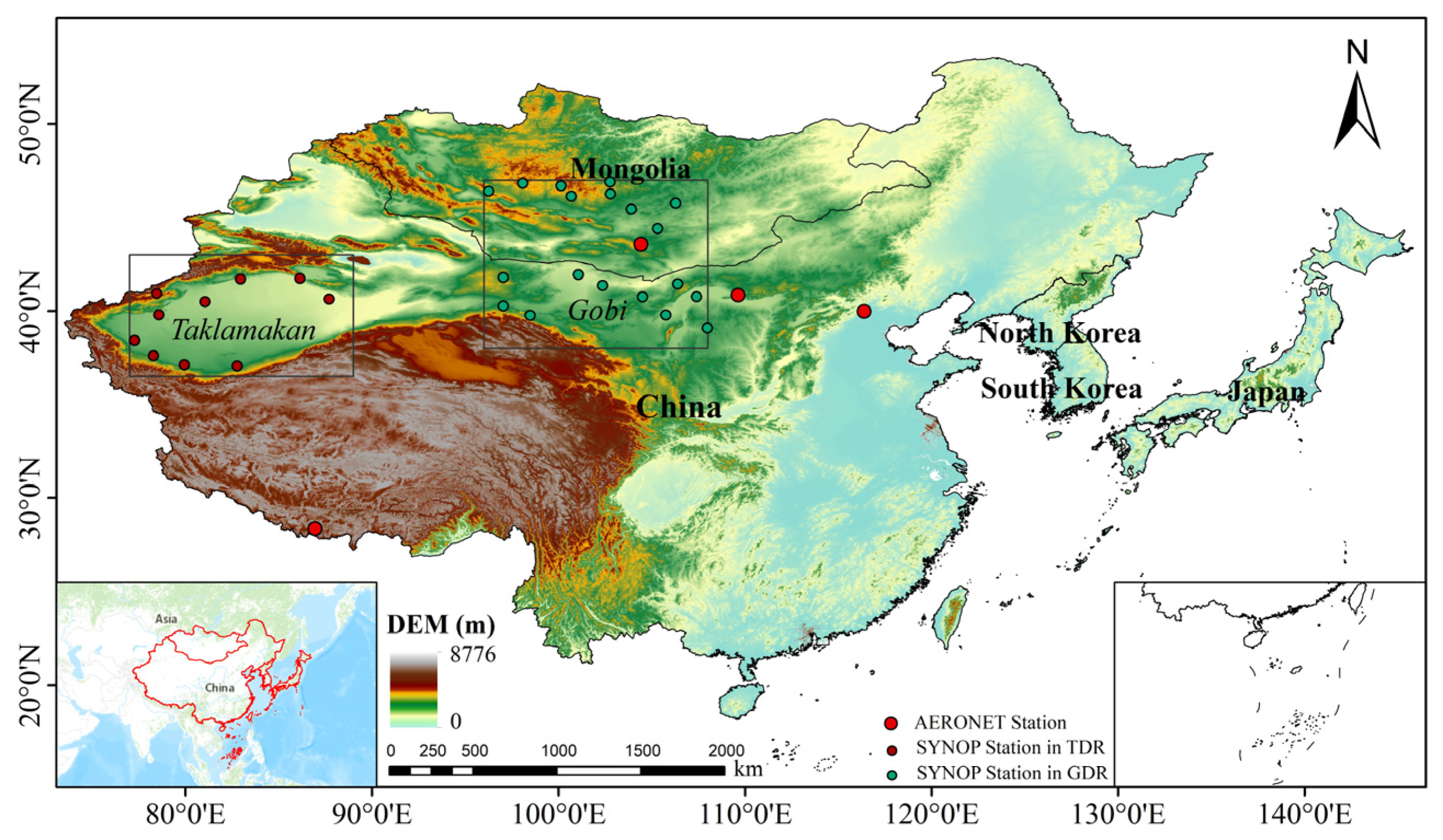
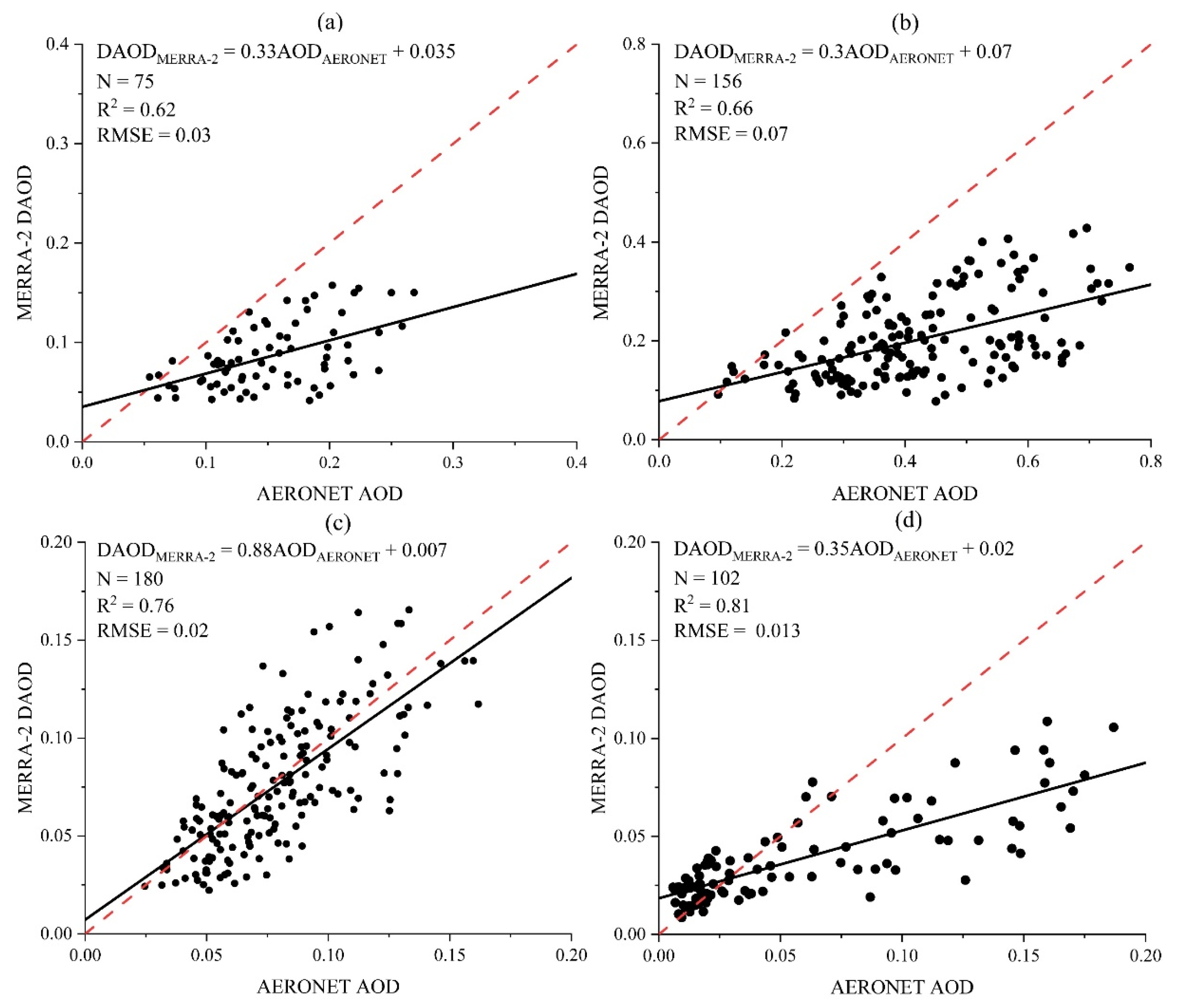
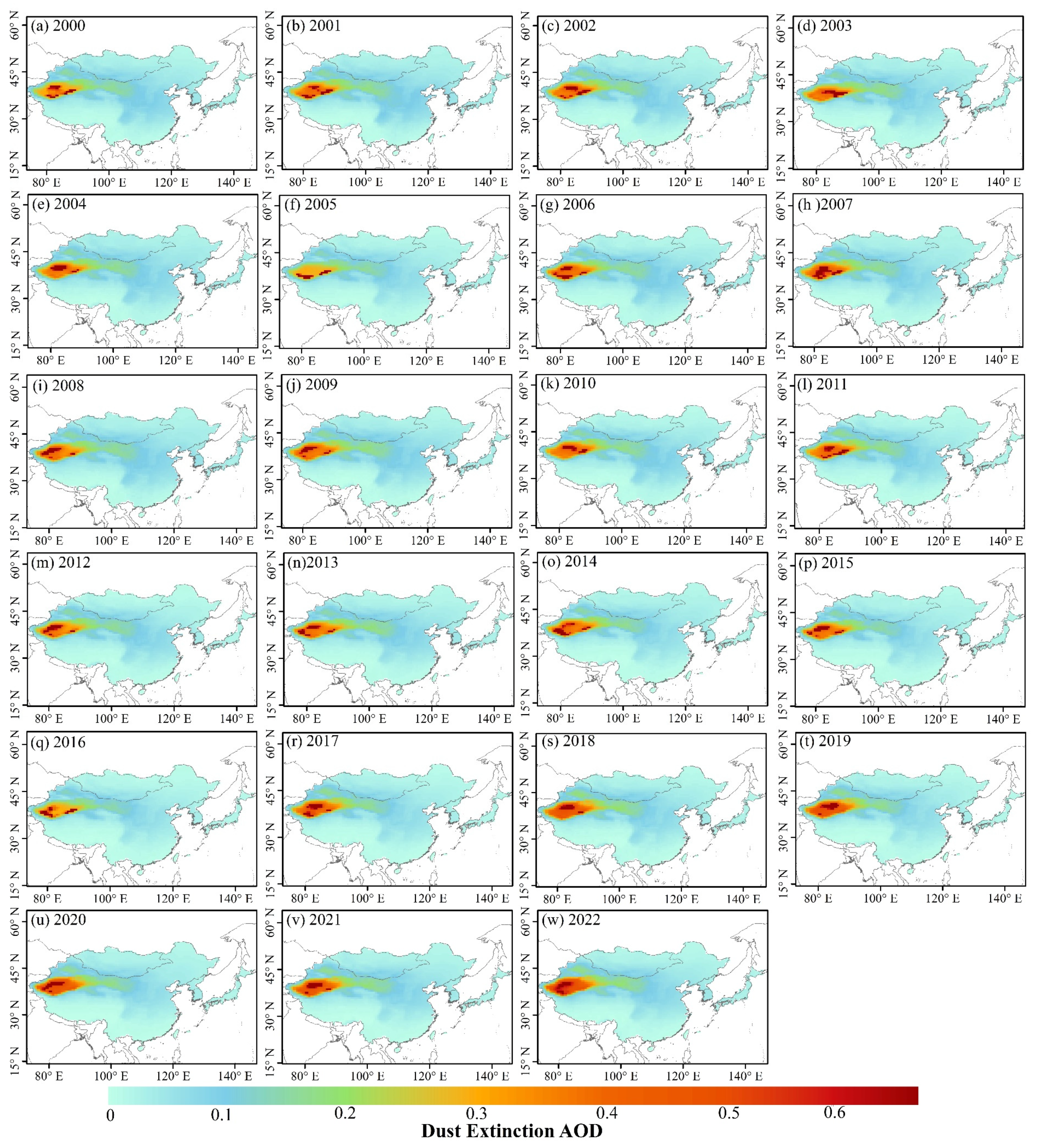
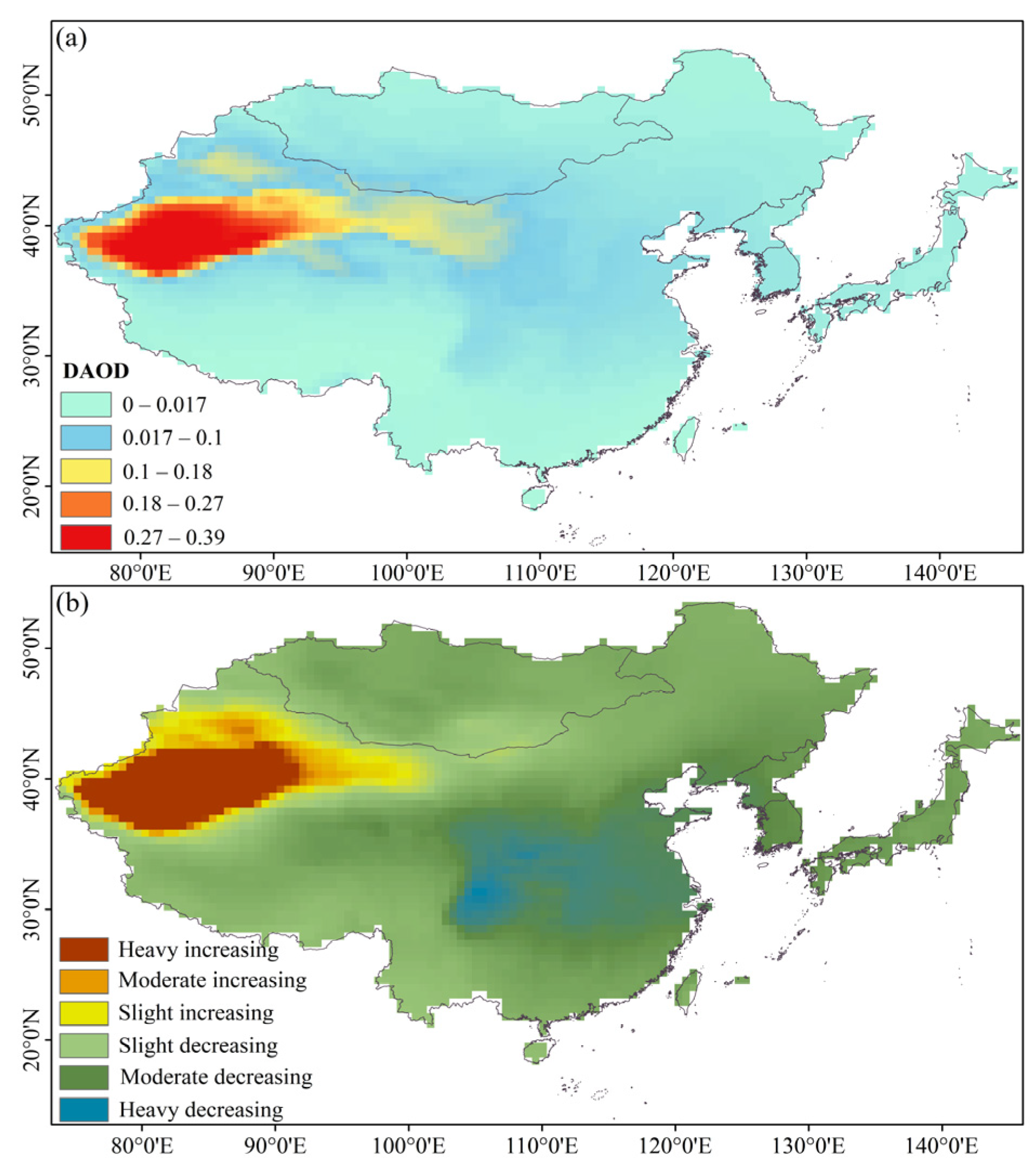

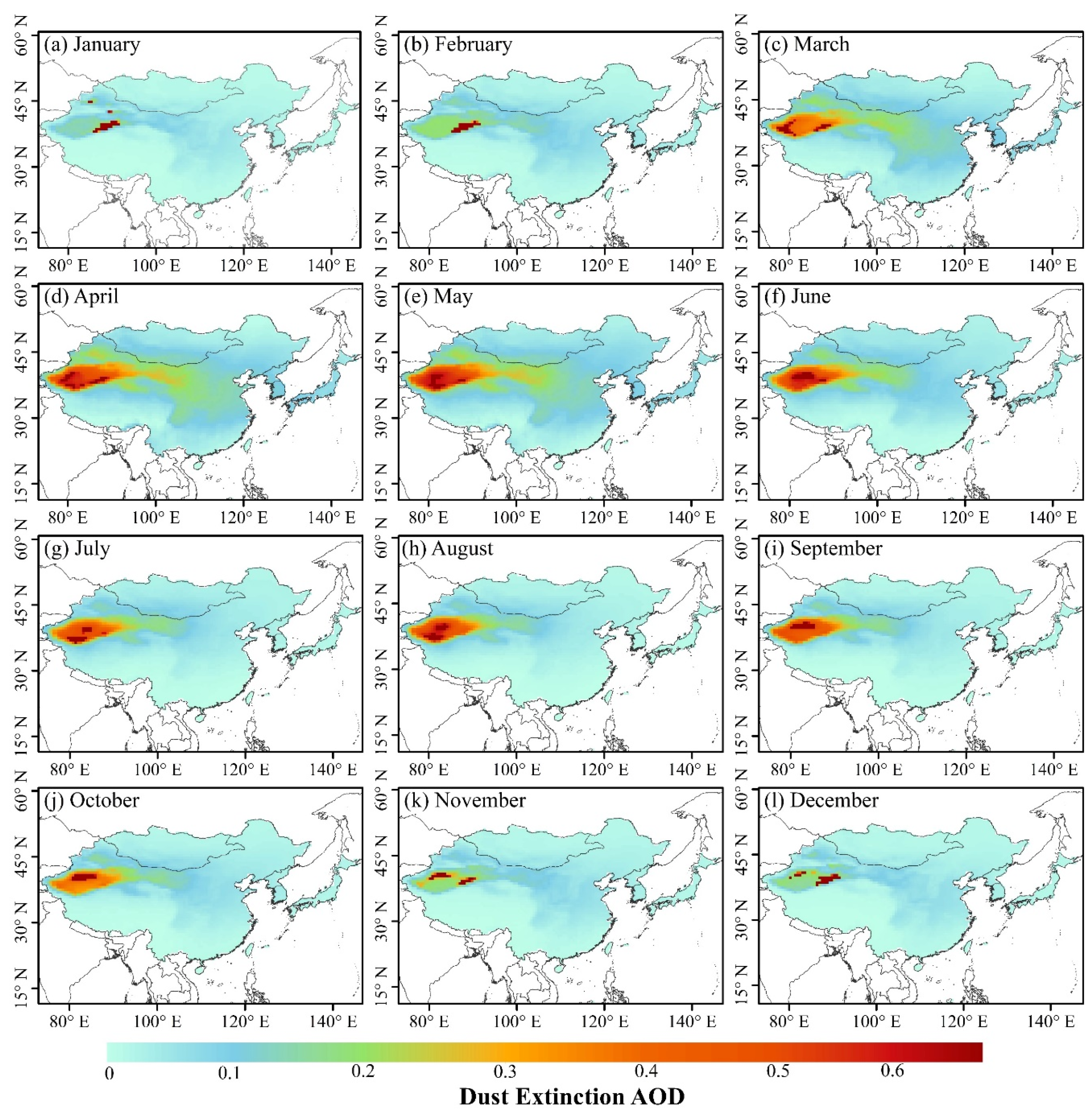
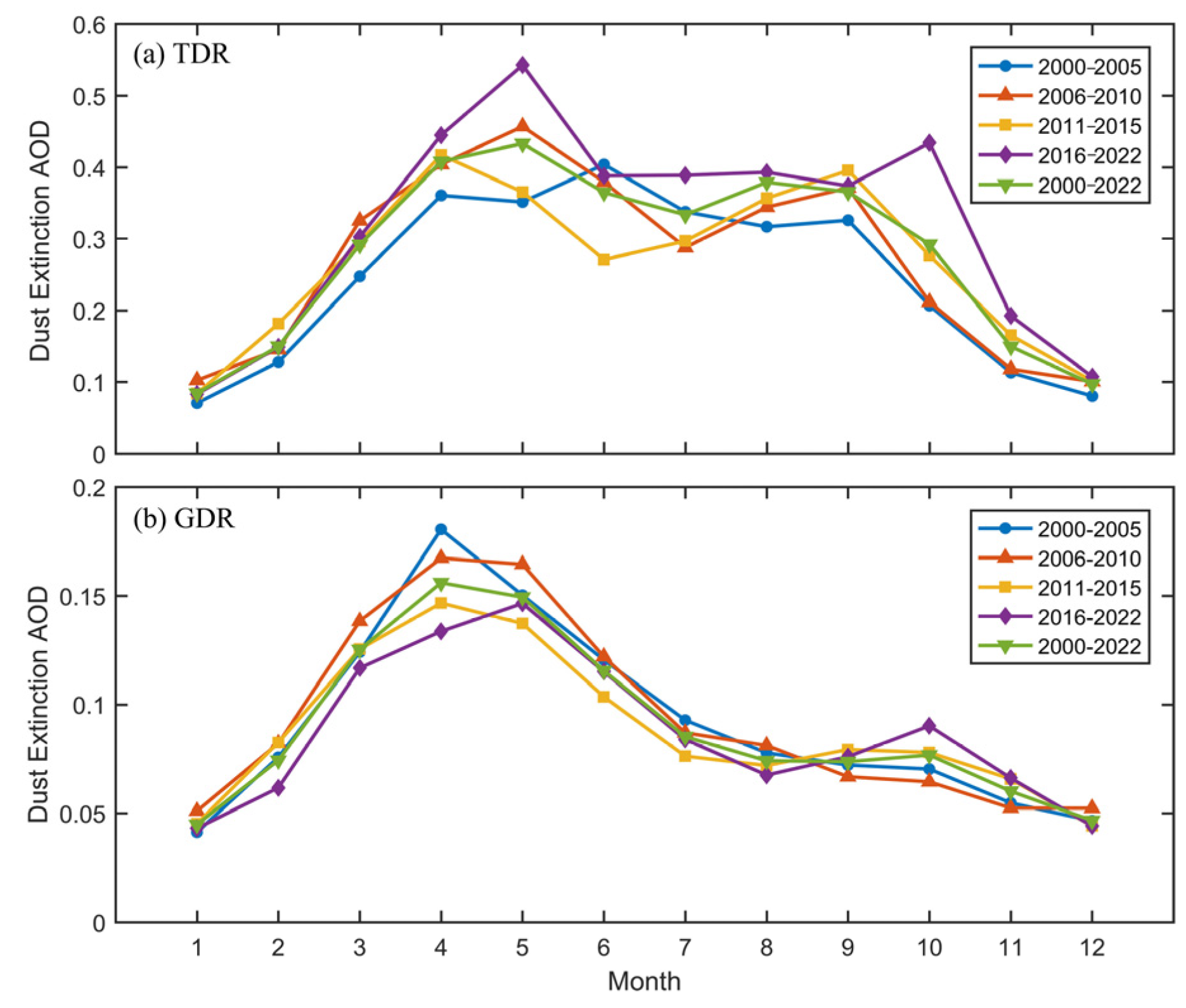

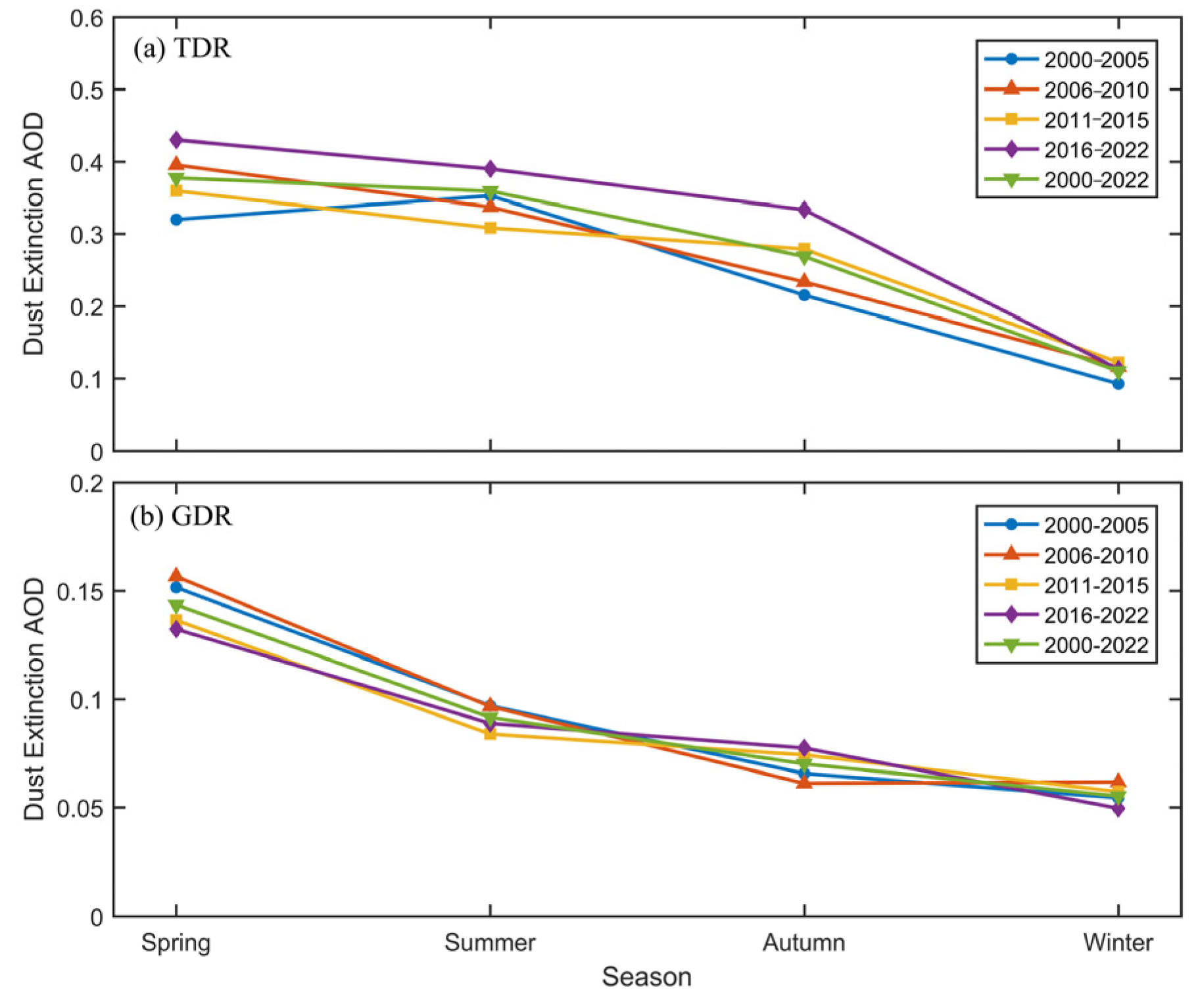
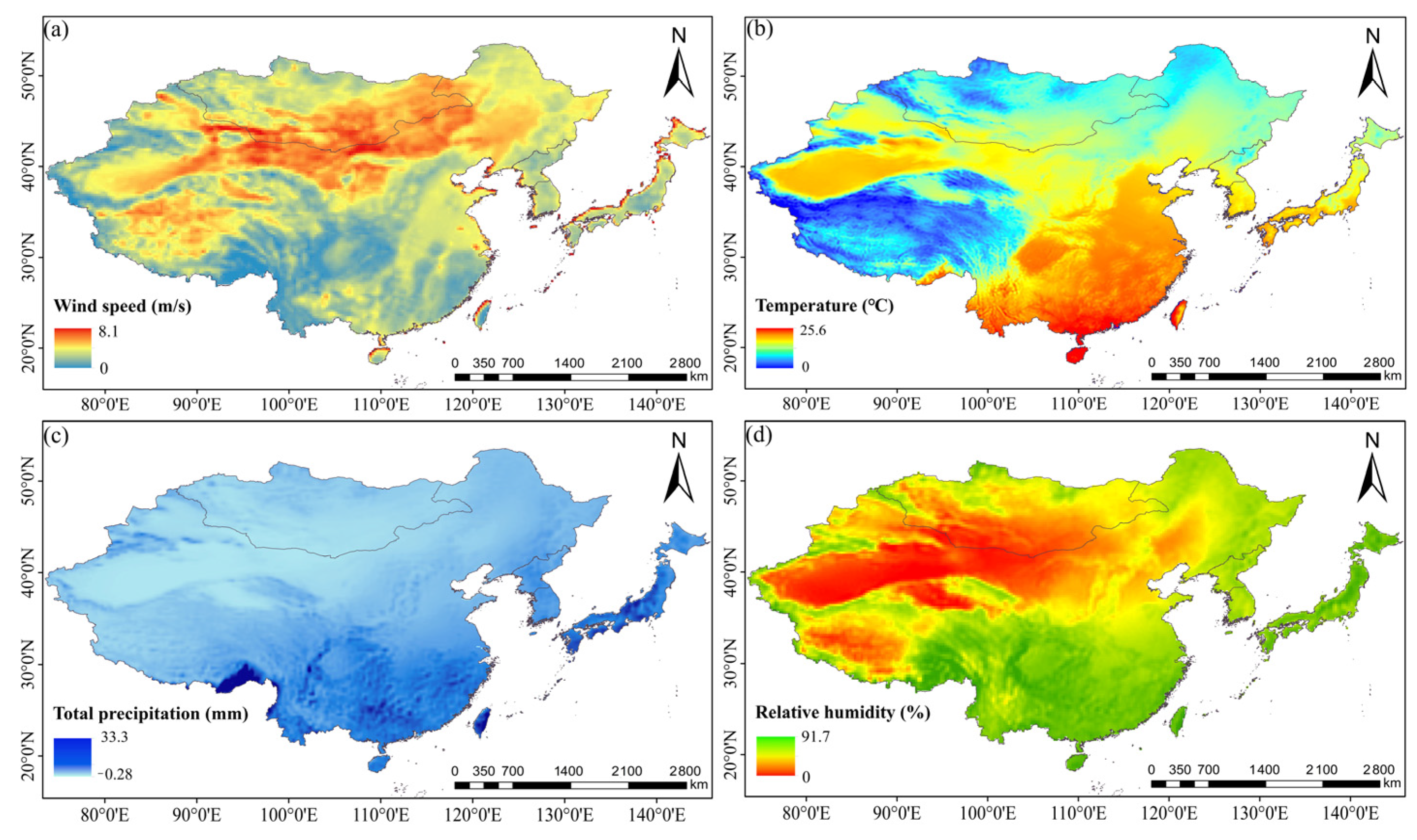
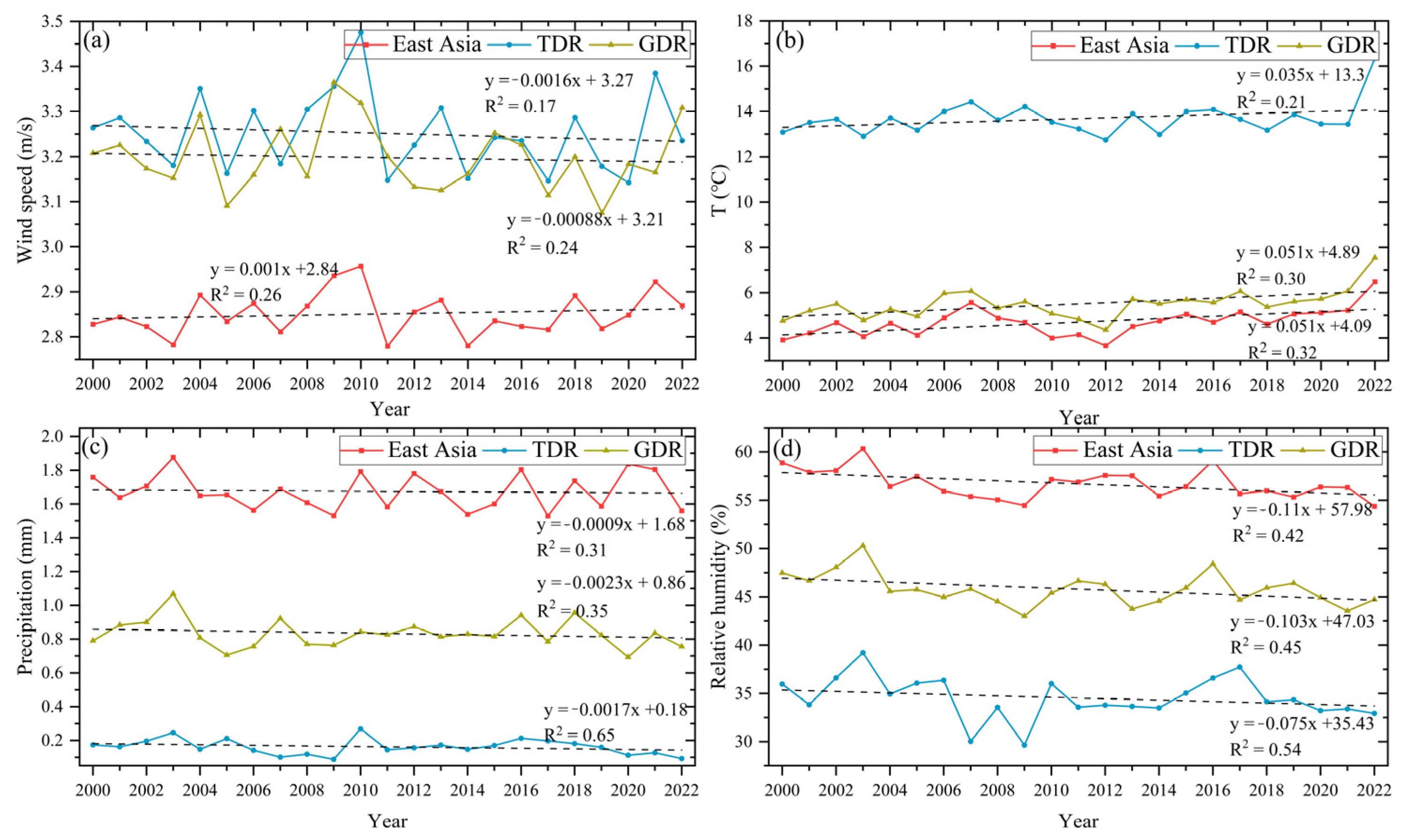
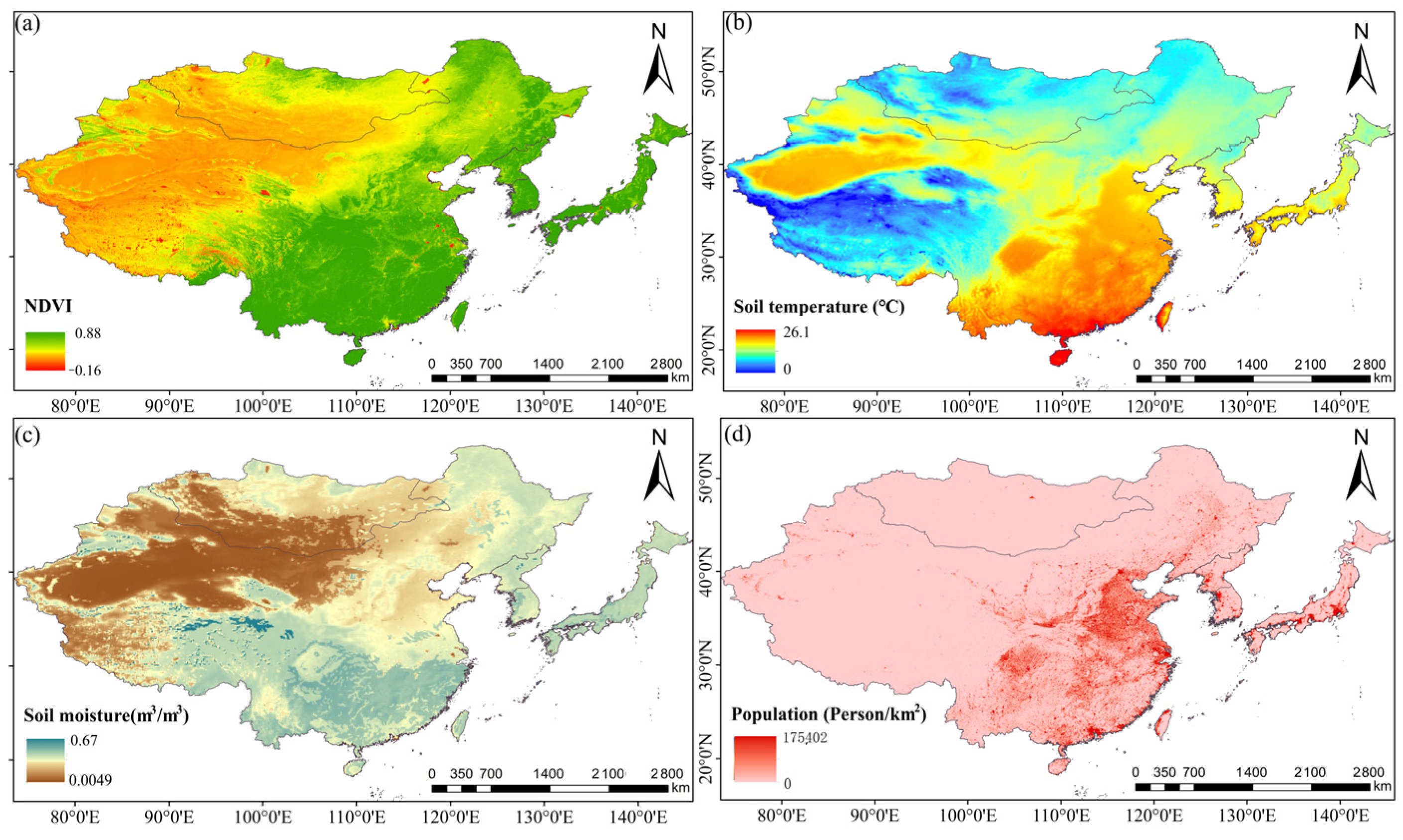


| Driving Factor | Variable | Unit | Spatial Resolution | Temporal Resolution | Data Source |
|---|---|---|---|---|---|
| Meteorological factors | 10 m wind speed | m/s | 0.1° | Monthly | EAR5 |
| Temperature | °C | 0.1° | Monthly | EAR5 | |
| Precipitation | mm | 0.1° | Monthly | EAR5 | |
| Relative Humidity | % | 0.1° | Monthly | EAR5 | |
| Ground conditions | NDVI | / | 1 km | 16 days | MODIS |
| Soil temperature | °C | 0.1° | Monthly | EAR5 | |
| Soil moisture | m3/m3 | 0.1° | Monthly | EAR5 | |
| Human activities | Population density | Person/km2 | 1 km | Monthly | WorldPop |
| Criterion | Interaction Relation |
|---|---|
| q(X1∩X2) < Min(q(X1), q(X2)) | Nonlinear weakening |
| Min(q(X1), q(X1)) < q(X1∩X1) < Max(q(X1), q(X1)) | One-factor nonlinear weakening |
| q(X1∩X1) > Max(q(X1), q(X1)) | Two-factor enhancement |
| q(X1∩X1) = q(X1) + q(X1) | Independent |
| q(X1∩X1) > q(X1) + q(X1) | Nonlinear enhancement |
| Results | Variable | 10 m Wind Speed | Temperature | Precipitation | Relative Humidity | NDVI | Soil Temperature | Soil Moisture | Population Density | |
|---|---|---|---|---|---|---|---|---|---|---|
| Region | ||||||||||
| East Asia | Pearson’s r | 0.33 | 0.40 | −0.48 | −0.61 | −0.40 | 0.38 | −0.58 | −0.16 | |
| GRA | 0.65 | 0.68 | 0.71 | 0.63 | 0.65 | 0.70 | 0.60 | 0.63 | ||
| q-value | 0.065 | 0.28 | 0.14 | 0.40 | 0.18 | 0.21 | 0.31 | 0.008 | ||
| TDR | Pearson’s r | 0.67 | 0.80 | −0.89 | −0.78 | −0.45 | 0.81 | −0.47 | −0.36 | |
| GRA | 0.71 | 0.67 | 0.64 | 0.64 | 0.63 | 0.65 | 0.62 | 0.55 | ||
| q-value | 0.60 | 0.70 | 0.72 | 0.88 | 0.26 | 0.39 | 0.48 | 0.30 | ||
| GDR | Pearson’s r | 0.30 | 0.79 | −0.27 | −0.69 | −0.37 | 0.87 | −0.44 | −0.26 | |
| GRA | 0.67 | 0.75 | 0.70 | 0.65 | 0.71 | 0.77 | 0.68 | 0.70 | ||
| q-value | 0.14 | 0.72 | 0.16 | 0.43 | 0.28 | 0.75 | 0.25 | 0.15 | ||
Disclaimer/Publisher’s Note: The statements, opinions and data contained in all publications are solely those of the individual author(s) and contributor(s) and not of MDPI and/or the editor(s). MDPI and/or the editor(s) disclaim responsibility for any injury to people or property resulting from any ideas, methods, instructions or products referred to in the content. |
© 2024 by the authors. Licensee MDPI, Basel, Switzerland. This article is an open access article distributed under the terms and conditions of the Creative Commons Attribution (CC BY) license (https://creativecommons.org/licenses/by/4.0/).
Share and Cite
Wang, Y.; Tang, J.; Wang, W.; Wang, Z.; Wang, J.; Liang, S.; Chu, B. Long-Term Spatiotemporal Characteristics and Influencing Factors of Dust Aerosols in East Asia (2000–2022). Remote Sens. 2024, 16, 318. https://doi.org/10.3390/rs16020318
Wang Y, Tang J, Wang W, Wang Z, Wang J, Liang S, Chu B. Long-Term Spatiotemporal Characteristics and Influencing Factors of Dust Aerosols in East Asia (2000–2022). Remote Sensing. 2024; 16(2):318. https://doi.org/10.3390/rs16020318
Chicago/Turabian StyleWang, Yanjiao, Jiakui Tang, Wuhua Wang, Zhao Wang, Jiru Wang, Shunbo Liang, and Bowen Chu. 2024. "Long-Term Spatiotemporal Characteristics and Influencing Factors of Dust Aerosols in East Asia (2000–2022)" Remote Sensing 16, no. 2: 318. https://doi.org/10.3390/rs16020318
APA StyleWang, Y., Tang, J., Wang, W., Wang, Z., Wang, J., Liang, S., & Chu, B. (2024). Long-Term Spatiotemporal Characteristics and Influencing Factors of Dust Aerosols in East Asia (2000–2022). Remote Sensing, 16(2), 318. https://doi.org/10.3390/rs16020318








